Dissertation: Motivating Employees in Multinational Corporations
VerifiedAdded on 2023/06/16
|20
|5626
|494
Thesis and Dissertation
AI Summary
This dissertation investigates the factors that motivate employees within multinational corporations (MNCs). It begins by establishing the importance of employee motivation for organizational success in a globalized business environment. The study identifies the problem of managing diverse motivational needs and expectations within MNCs. A qualitative research approach is adopted, drawing upon established motivational theories such as Maslow's Hierarchy of Needs, Herzberg's Two-Factor Theory, and Lawrence's Four-Drive Theory to provide a theoretical framework. The research explores the concepts of intrinsic and extrinsic motivation, examining how factors such as creative work, high salary, growth opportunities, and positive relationships influence employee attitudes and performance. Data analysis includes descriptive statistics, correlation analysis, and ANOVA to assess the relationship between various motivational factors and employee outcomes. The dissertation concludes by summarizing key findings and offering insights into effective motivation strategies for MNCs.
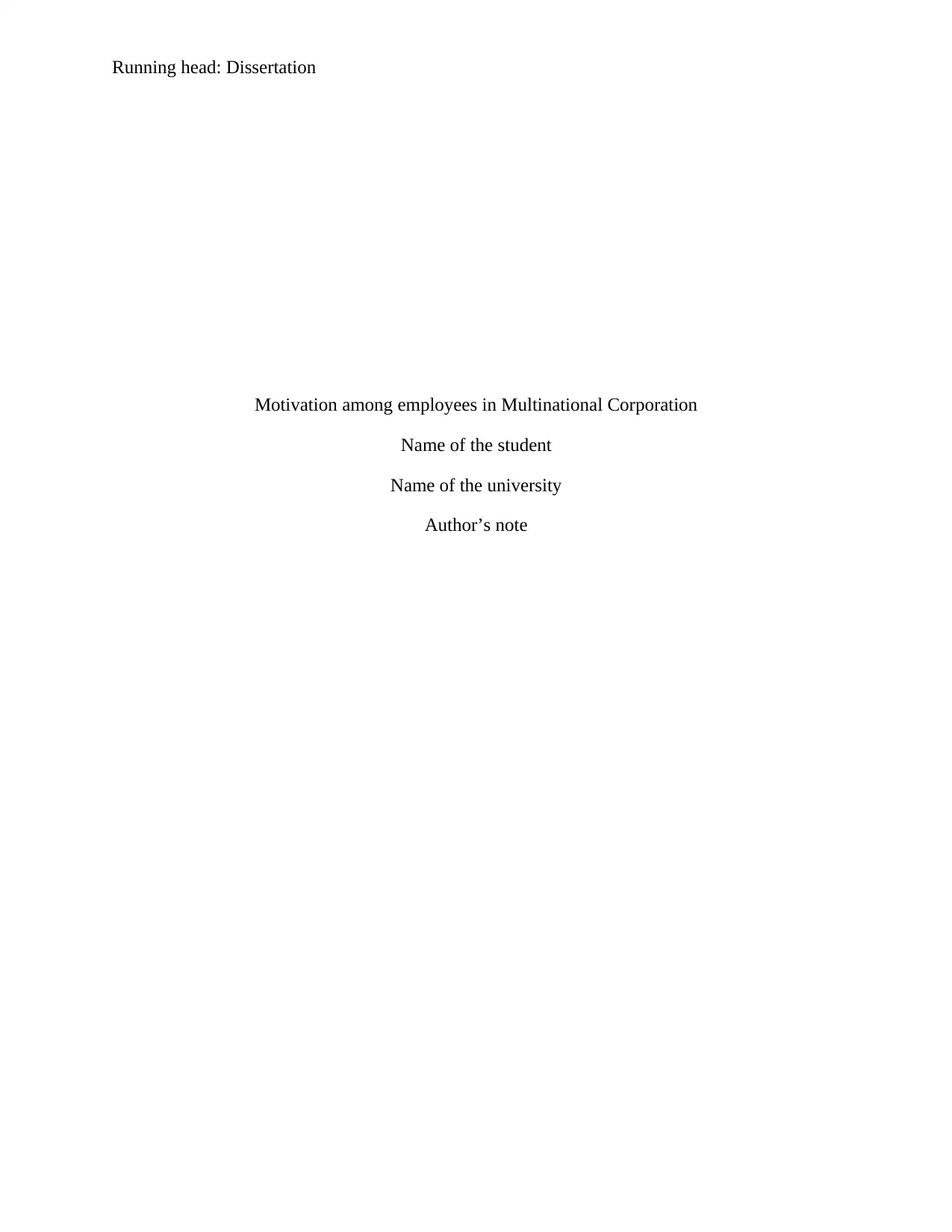
Running head: Dissertation
Motivation among employees in Multinational Corporation
Name of the student
Name of the university
Author’s note
Motivation among employees in Multinational Corporation
Name of the student
Name of the university
Author’s note
Paraphrase This Document
Need a fresh take? Get an instant paraphrase of this document with our AI Paraphraser
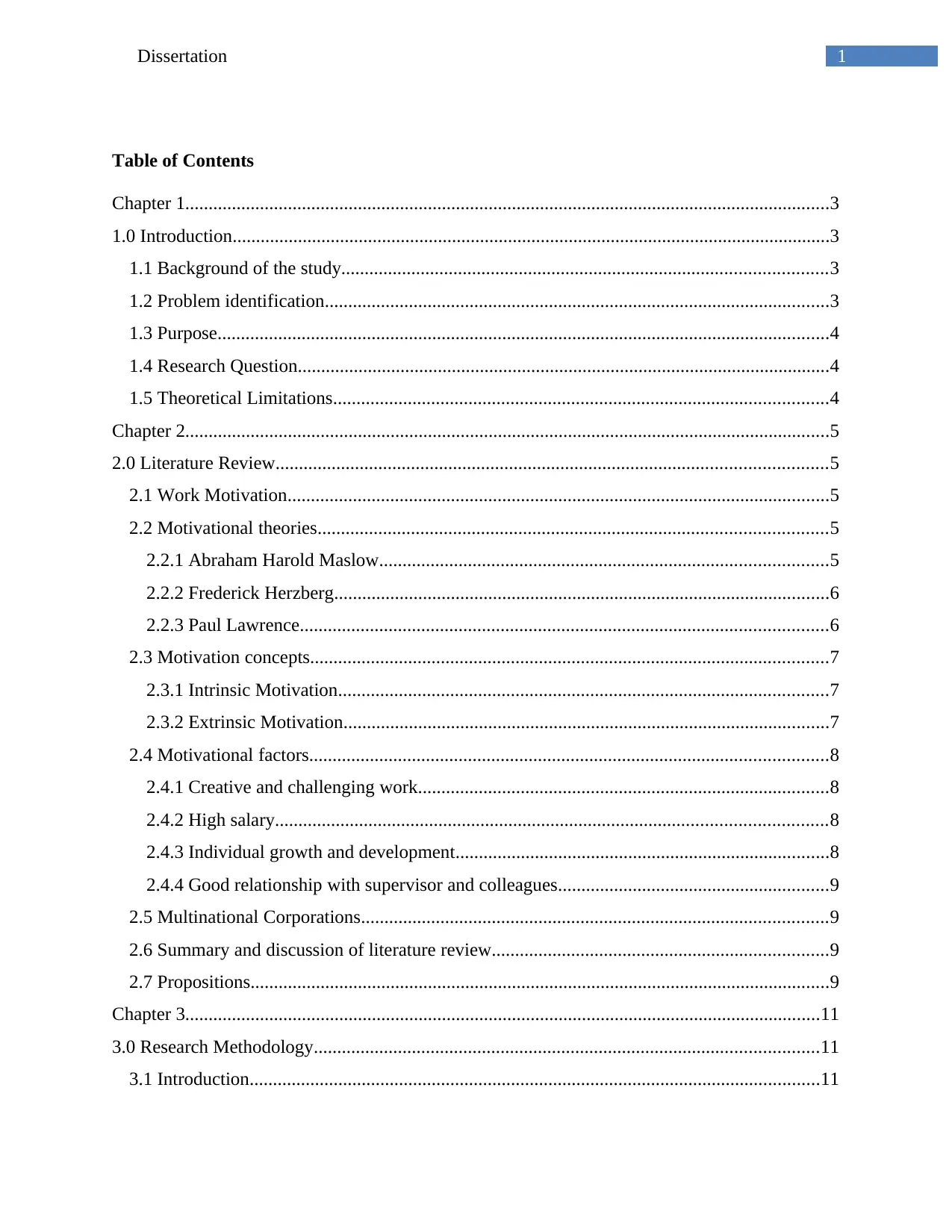
1Dissertation
Table of Contents
Chapter 1..........................................................................................................................................3
1.0 Introduction................................................................................................................................3
1.1 Background of the study........................................................................................................3
1.2 Problem identification............................................................................................................3
1.3 Purpose...................................................................................................................................4
1.4 Research Question..................................................................................................................4
1.5 Theoretical Limitations..........................................................................................................4
Chapter 2..........................................................................................................................................5
2.0 Literature Review......................................................................................................................5
2.1 Work Motivation....................................................................................................................5
2.2 Motivational theories.............................................................................................................5
2.2.1 Abraham Harold Maslow................................................................................................5
2.2.2 Frederick Herzberg..........................................................................................................6
2.2.3 Paul Lawrence.................................................................................................................6
2.3 Motivation concepts...............................................................................................................7
2.3.1 Intrinsic Motivation.........................................................................................................7
2.3.2 Extrinsic Motivation........................................................................................................7
2.4 Motivational factors...............................................................................................................8
2.4.1 Creative and challenging work........................................................................................8
2.4.2 High salary......................................................................................................................8
2.4.3 Individual growth and development................................................................................8
2.4.4 Good relationship with supervisor and colleagues..........................................................9
2.5 Multinational Corporations....................................................................................................9
2.6 Summary and discussion of literature review........................................................................9
2.7 Propositions............................................................................................................................9
Chapter 3........................................................................................................................................11
3.0 Research Methodology............................................................................................................11
3.1 Introduction..........................................................................................................................11
Table of Contents
Chapter 1..........................................................................................................................................3
1.0 Introduction................................................................................................................................3
1.1 Background of the study........................................................................................................3
1.2 Problem identification............................................................................................................3
1.3 Purpose...................................................................................................................................4
1.4 Research Question..................................................................................................................4
1.5 Theoretical Limitations..........................................................................................................4
Chapter 2..........................................................................................................................................5
2.0 Literature Review......................................................................................................................5
2.1 Work Motivation....................................................................................................................5
2.2 Motivational theories.............................................................................................................5
2.2.1 Abraham Harold Maslow................................................................................................5
2.2.2 Frederick Herzberg..........................................................................................................6
2.2.3 Paul Lawrence.................................................................................................................6
2.3 Motivation concepts...............................................................................................................7
2.3.1 Intrinsic Motivation.........................................................................................................7
2.3.2 Extrinsic Motivation........................................................................................................7
2.4 Motivational factors...............................................................................................................8
2.4.1 Creative and challenging work........................................................................................8
2.4.2 High salary......................................................................................................................8
2.4.3 Individual growth and development................................................................................8
2.4.4 Good relationship with supervisor and colleagues..........................................................9
2.5 Multinational Corporations....................................................................................................9
2.6 Summary and discussion of literature review........................................................................9
2.7 Propositions............................................................................................................................9
Chapter 3........................................................................................................................................11
3.0 Research Methodology............................................................................................................11
3.1 Introduction..........................................................................................................................11
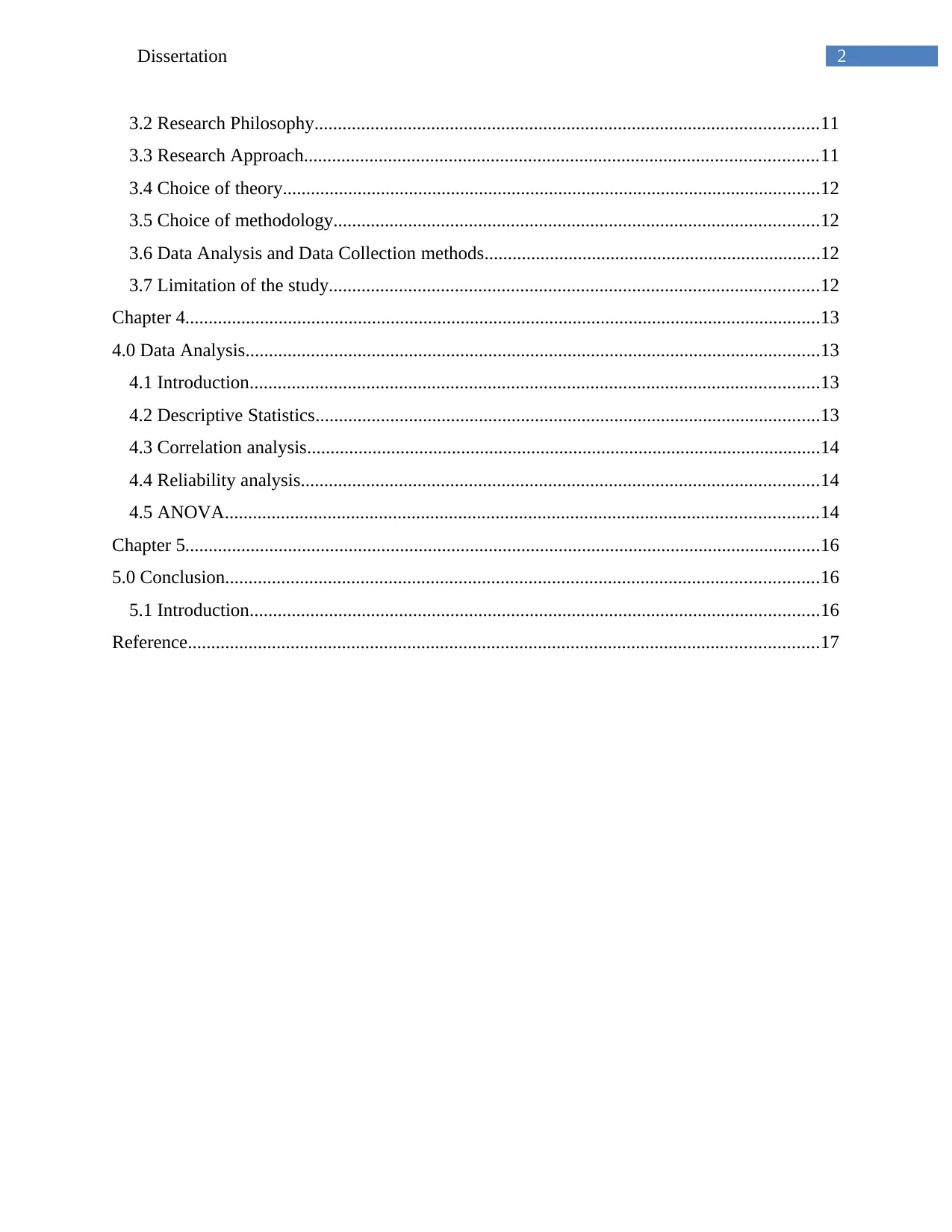
2Dissertation
3.2 Research Philosophy............................................................................................................11
3.3 Research Approach..............................................................................................................11
3.4 Choice of theory...................................................................................................................12
3.5 Choice of methodology........................................................................................................12
3.6 Data Analysis and Data Collection methods........................................................................12
3.7 Limitation of the study.........................................................................................................12
Chapter 4........................................................................................................................................13
4.0 Data Analysis...........................................................................................................................13
4.1 Introduction..........................................................................................................................13
4.2 Descriptive Statistics............................................................................................................13
4.3 Correlation analysis..............................................................................................................14
4.4 Reliability analysis...............................................................................................................14
4.5 ANOVA...............................................................................................................................14
Chapter 5........................................................................................................................................16
5.0 Conclusion...............................................................................................................................16
5.1 Introduction..........................................................................................................................16
Reference.......................................................................................................................................17
3.2 Research Philosophy............................................................................................................11
3.3 Research Approach..............................................................................................................11
3.4 Choice of theory...................................................................................................................12
3.5 Choice of methodology........................................................................................................12
3.6 Data Analysis and Data Collection methods........................................................................12
3.7 Limitation of the study.........................................................................................................12
Chapter 4........................................................................................................................................13
4.0 Data Analysis...........................................................................................................................13
4.1 Introduction..........................................................................................................................13
4.2 Descriptive Statistics............................................................................................................13
4.3 Correlation analysis..............................................................................................................14
4.4 Reliability analysis...............................................................................................................14
4.5 ANOVA...............................................................................................................................14
Chapter 5........................................................................................................................................16
5.0 Conclusion...............................................................................................................................16
5.1 Introduction..........................................................................................................................16
Reference.......................................................................................................................................17
⊘ This is a preview!⊘
Do you want full access?
Subscribe today to unlock all pages.

Trusted by 1+ million students worldwide
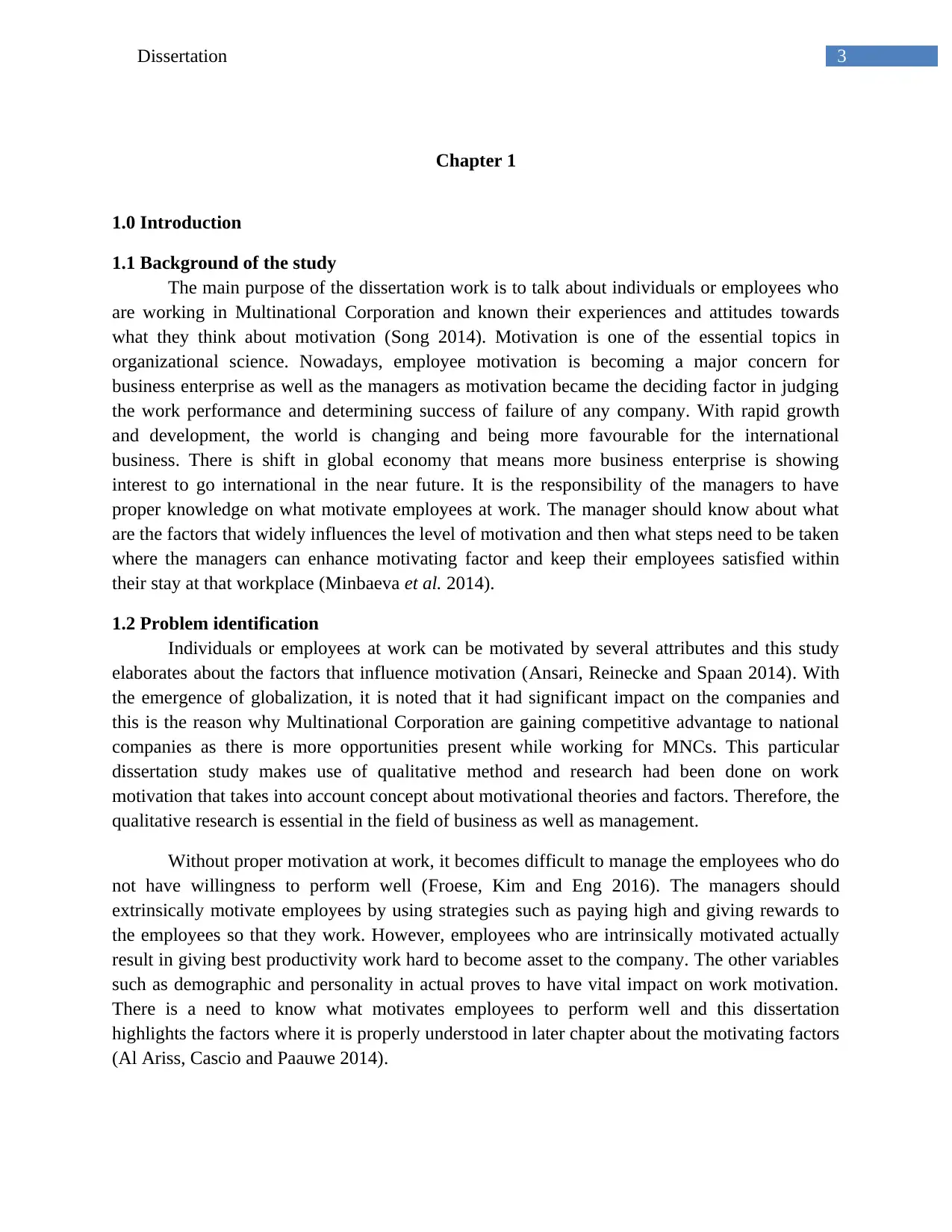
3Dissertation
Chapter 1
1.0 Introduction
1.1 Background of the study
The main purpose of the dissertation work is to talk about individuals or employees who
are working in Multinational Corporation and known their experiences and attitudes towards
what they think about motivation (Song 2014). Motivation is one of the essential topics in
organizational science. Nowadays, employee motivation is becoming a major concern for
business enterprise as well as the managers as motivation became the deciding factor in judging
the work performance and determining success of failure of any company. With rapid growth
and development, the world is changing and being more favourable for the international
business. There is shift in global economy that means more business enterprise is showing
interest to go international in the near future. It is the responsibility of the managers to have
proper knowledge on what motivate employees at work. The manager should know about what
are the factors that widely influences the level of motivation and then what steps need to be taken
where the managers can enhance motivating factor and keep their employees satisfied within
their stay at that workplace (Minbaeva et al. 2014).
1.2 Problem identification
Individuals or employees at work can be motivated by several attributes and this study
elaborates about the factors that influence motivation (Ansari, Reinecke and Spaan 2014). With
the emergence of globalization, it is noted that it had significant impact on the companies and
this is the reason why Multinational Corporation are gaining competitive advantage to national
companies as there is more opportunities present while working for MNCs. This particular
dissertation study makes use of qualitative method and research had been done on work
motivation that takes into account concept about motivational theories and factors. Therefore, the
qualitative research is essential in the field of business as well as management.
Without proper motivation at work, it becomes difficult to manage the employees who do
not have willingness to perform well (Froese, Kim and Eng 2016). The managers should
extrinsically motivate employees by using strategies such as paying high and giving rewards to
the employees so that they work. However, employees who are intrinsically motivated actually
result in giving best productivity work hard to become asset to the company. The other variables
such as demographic and personality in actual proves to have vital impact on work motivation.
There is a need to know what motivates employees to perform well and this dissertation
highlights the factors where it is properly understood in later chapter about the motivating factors
(Al Ariss, Cascio and Paauwe 2014).
Chapter 1
1.0 Introduction
1.1 Background of the study
The main purpose of the dissertation work is to talk about individuals or employees who
are working in Multinational Corporation and known their experiences and attitudes towards
what they think about motivation (Song 2014). Motivation is one of the essential topics in
organizational science. Nowadays, employee motivation is becoming a major concern for
business enterprise as well as the managers as motivation became the deciding factor in judging
the work performance and determining success of failure of any company. With rapid growth
and development, the world is changing and being more favourable for the international
business. There is shift in global economy that means more business enterprise is showing
interest to go international in the near future. It is the responsibility of the managers to have
proper knowledge on what motivate employees at work. The manager should know about what
are the factors that widely influences the level of motivation and then what steps need to be taken
where the managers can enhance motivating factor and keep their employees satisfied within
their stay at that workplace (Minbaeva et al. 2014).
1.2 Problem identification
Individuals or employees at work can be motivated by several attributes and this study
elaborates about the factors that influence motivation (Ansari, Reinecke and Spaan 2014). With
the emergence of globalization, it is noted that it had significant impact on the companies and
this is the reason why Multinational Corporation are gaining competitive advantage to national
companies as there is more opportunities present while working for MNCs. This particular
dissertation study makes use of qualitative method and research had been done on work
motivation that takes into account concept about motivational theories and factors. Therefore, the
qualitative research is essential in the field of business as well as management.
Without proper motivation at work, it becomes difficult to manage the employees who do
not have willingness to perform well (Froese, Kim and Eng 2016). The managers should
extrinsically motivate employees by using strategies such as paying high and giving rewards to
the employees so that they work. However, employees who are intrinsically motivated actually
result in giving best productivity work hard to become asset to the company. The other variables
such as demographic and personality in actual proves to have vital impact on work motivation.
There is a need to know what motivates employees to perform well and this dissertation
highlights the factors where it is properly understood in later chapter about the motivating factors
(Al Ariss, Cascio and Paauwe 2014).
Paraphrase This Document
Need a fresh take? Get an instant paraphrase of this document with our AI Paraphraser
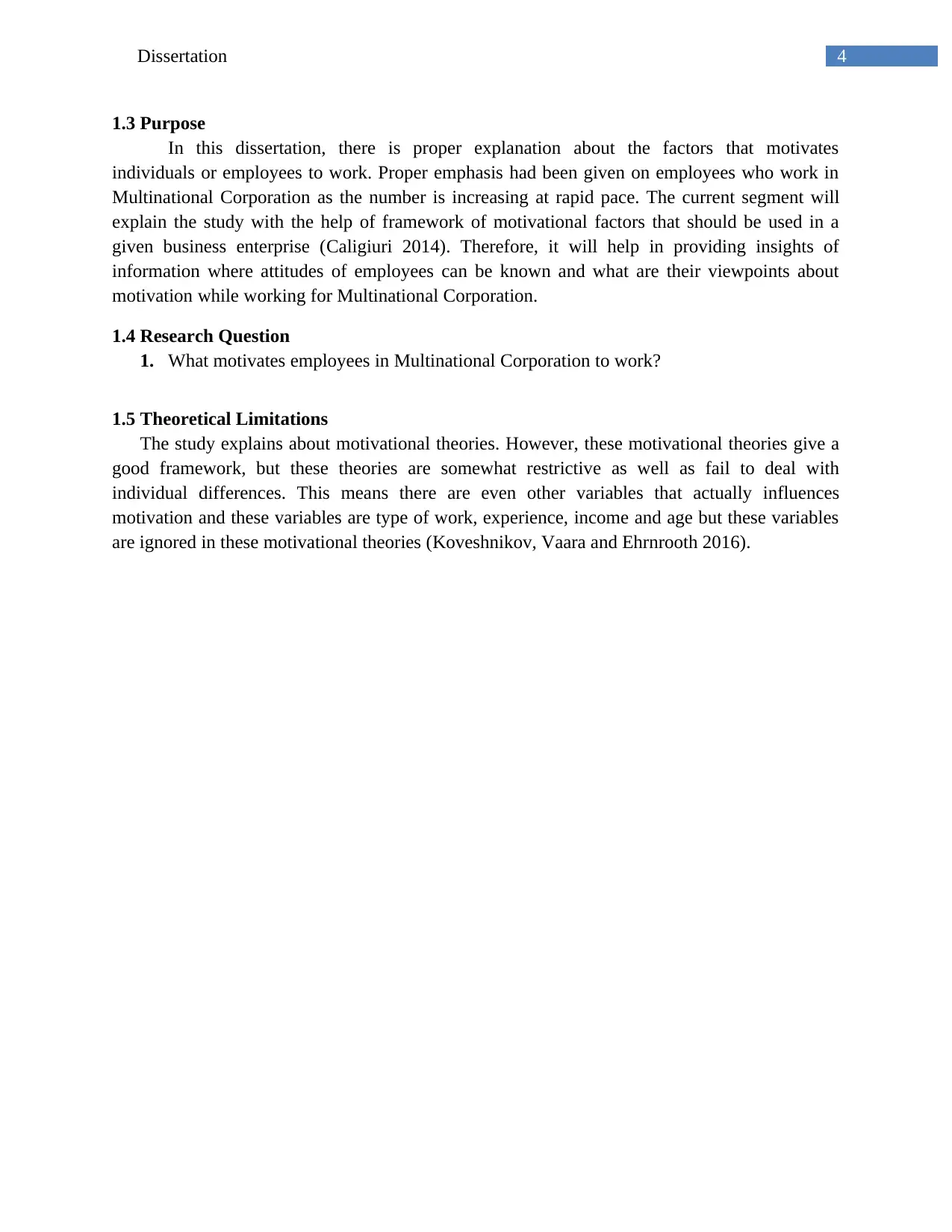
4Dissertation
1.3 Purpose
In this dissertation, there is proper explanation about the factors that motivates
individuals or employees to work. Proper emphasis had been given on employees who work in
Multinational Corporation as the number is increasing at rapid pace. The current segment will
explain the study with the help of framework of motivational factors that should be used in a
given business enterprise (Caligiuri 2014). Therefore, it will help in providing insights of
information where attitudes of employees can be known and what are their viewpoints about
motivation while working for Multinational Corporation.
1.4 Research Question
1. What motivates employees in Multinational Corporation to work?
1.5 Theoretical Limitations
The study explains about motivational theories. However, these motivational theories give a
good framework, but these theories are somewhat restrictive as well as fail to deal with
individual differences. This means there are even other variables that actually influences
motivation and these variables are type of work, experience, income and age but these variables
are ignored in these motivational theories (Koveshnikov, Vaara and Ehrnrooth 2016).
1.3 Purpose
In this dissertation, there is proper explanation about the factors that motivates
individuals or employees to work. Proper emphasis had been given on employees who work in
Multinational Corporation as the number is increasing at rapid pace. The current segment will
explain the study with the help of framework of motivational factors that should be used in a
given business enterprise (Caligiuri 2014). Therefore, it will help in providing insights of
information where attitudes of employees can be known and what are their viewpoints about
motivation while working for Multinational Corporation.
1.4 Research Question
1. What motivates employees in Multinational Corporation to work?
1.5 Theoretical Limitations
The study explains about motivational theories. However, these motivational theories give a
good framework, but these theories are somewhat restrictive as well as fail to deal with
individual differences. This means there are even other variables that actually influences
motivation and these variables are type of work, experience, income and age but these variables
are ignored in these motivational theories (Koveshnikov, Vaara and Ehrnrooth 2016).
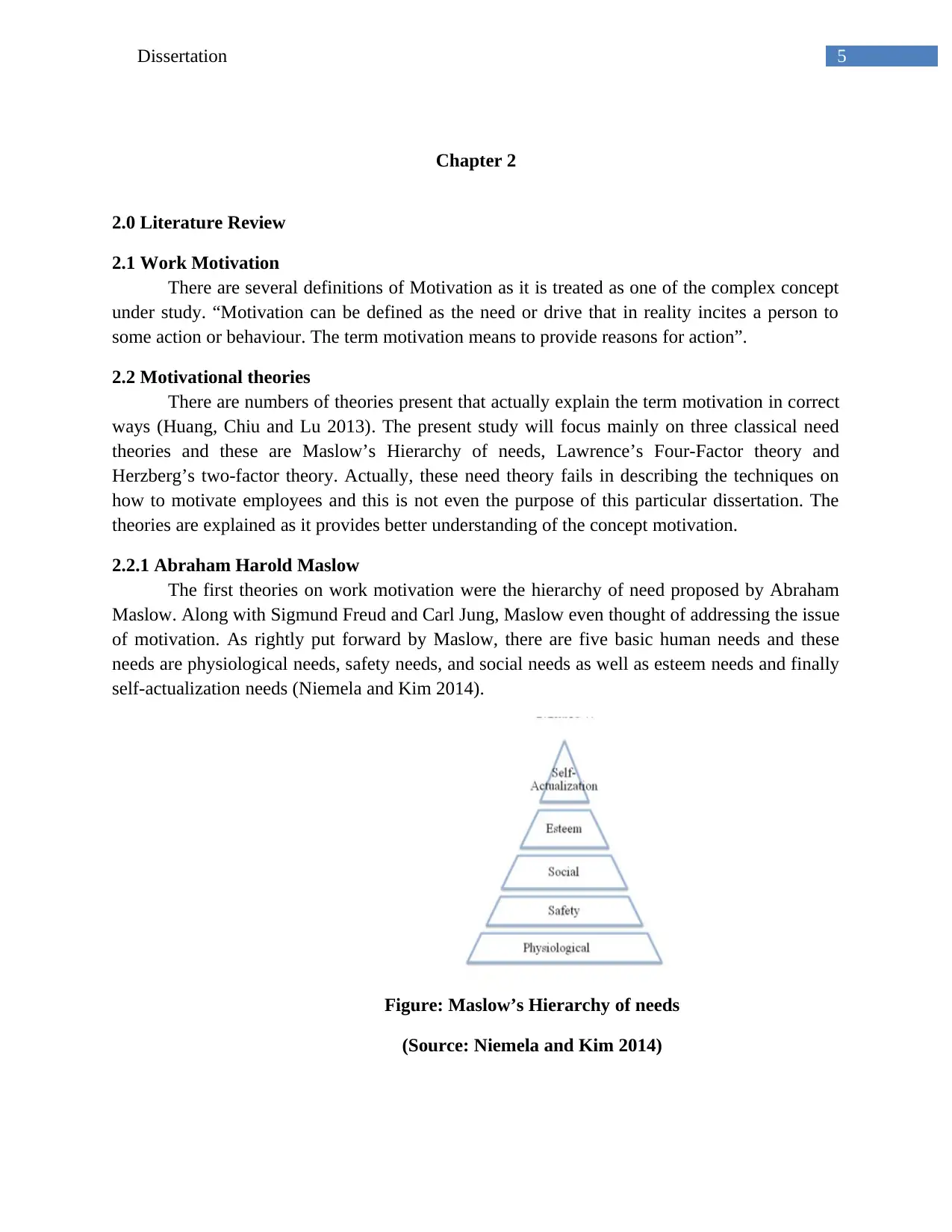
5Dissertation
Chapter 2
2.0 Literature Review
2.1 Work Motivation
There are several definitions of Motivation as it is treated as one of the complex concept
under study. “Motivation can be defined as the need or drive that in reality incites a person to
some action or behaviour. The term motivation means to provide reasons for action”.
2.2 Motivational theories
There are numbers of theories present that actually explain the term motivation in correct
ways (Huang, Chiu and Lu 2013). The present study will focus mainly on three classical need
theories and these are Maslow’s Hierarchy of needs, Lawrence’s Four-Factor theory and
Herzberg’s two-factor theory. Actually, these need theory fails in describing the techniques on
how to motivate employees and this is not even the purpose of this particular dissertation. The
theories are explained as it provides better understanding of the concept motivation.
2.2.1 Abraham Harold Maslow
The first theories on work motivation were the hierarchy of need proposed by Abraham
Maslow. Along with Sigmund Freud and Carl Jung, Maslow even thought of addressing the issue
of motivation. As rightly put forward by Maslow, there are five basic human needs and these
needs are physiological needs, safety needs, and social needs as well as esteem needs and finally
self-actualization needs (Niemela and Kim 2014).
Figure: Maslow’s Hierarchy of needs
(Source: Niemela and Kim 2014)
Chapter 2
2.0 Literature Review
2.1 Work Motivation
There are several definitions of Motivation as it is treated as one of the complex concept
under study. “Motivation can be defined as the need or drive that in reality incites a person to
some action or behaviour. The term motivation means to provide reasons for action”.
2.2 Motivational theories
There are numbers of theories present that actually explain the term motivation in correct
ways (Huang, Chiu and Lu 2013). The present study will focus mainly on three classical need
theories and these are Maslow’s Hierarchy of needs, Lawrence’s Four-Factor theory and
Herzberg’s two-factor theory. Actually, these need theory fails in describing the techniques on
how to motivate employees and this is not even the purpose of this particular dissertation. The
theories are explained as it provides better understanding of the concept motivation.
2.2.1 Abraham Harold Maslow
The first theories on work motivation were the hierarchy of need proposed by Abraham
Maslow. Along with Sigmund Freud and Carl Jung, Maslow even thought of addressing the issue
of motivation. As rightly put forward by Maslow, there are five basic human needs and these
needs are physiological needs, safety needs, and social needs as well as esteem needs and finally
self-actualization needs (Niemela and Kim 2014).
Figure: Maslow’s Hierarchy of needs
(Source: Niemela and Kim 2014)
⊘ This is a preview!⊘
Do you want full access?
Subscribe today to unlock all pages.

Trusted by 1+ million students worldwide
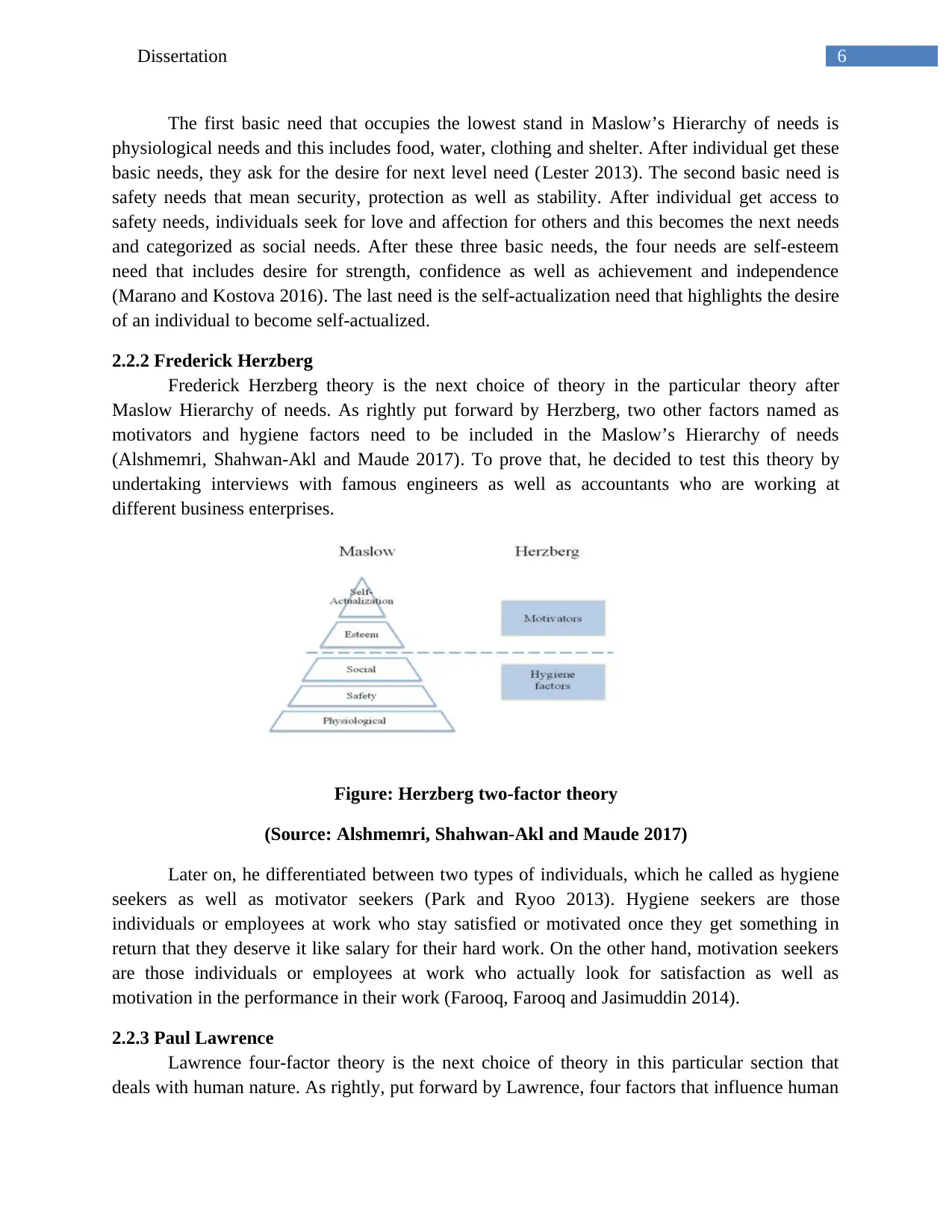
6Dissertation
The first basic need that occupies the lowest stand in Maslow’s Hierarchy of needs is
physiological needs and this includes food, water, clothing and shelter. After individual get these
basic needs, they ask for the desire for next level need (Lester 2013). The second basic need is
safety needs that mean security, protection as well as stability. After individual get access to
safety needs, individuals seek for love and affection for others and this becomes the next needs
and categorized as social needs. After these three basic needs, the four needs are self-esteem
need that includes desire for strength, confidence as well as achievement and independence
(Marano and Kostova 2016). The last need is the self-actualization need that highlights the desire
of an individual to become self-actualized.
2.2.2 Frederick Herzberg
Frederick Herzberg theory is the next choice of theory in the particular theory after
Maslow Hierarchy of needs. As rightly put forward by Herzberg, two other factors named as
motivators and hygiene factors need to be included in the Maslow’s Hierarchy of needs
(Alshmemri, Shahwan-Akl and Maude 2017). To prove that, he decided to test this theory by
undertaking interviews with famous engineers as well as accountants who are working at
different business enterprises.
Figure: Herzberg two-factor theory
(Source: Alshmemri, Shahwan-Akl and Maude 2017)
Later on, he differentiated between two types of individuals, which he called as hygiene
seekers as well as motivator seekers (Park and Ryoo 2013). Hygiene seekers are those
individuals or employees at work who stay satisfied or motivated once they get something in
return that they deserve it like salary for their hard work. On the other hand, motivation seekers
are those individuals or employees at work who actually look for satisfaction as well as
motivation in the performance in their work (Farooq, Farooq and Jasimuddin 2014).
2.2.3 Paul Lawrence
Lawrence four-factor theory is the next choice of theory in this particular section that
deals with human nature. As rightly, put forward by Lawrence, four factors that influence human
The first basic need that occupies the lowest stand in Maslow’s Hierarchy of needs is
physiological needs and this includes food, water, clothing and shelter. After individual get these
basic needs, they ask for the desire for next level need (Lester 2013). The second basic need is
safety needs that mean security, protection as well as stability. After individual get access to
safety needs, individuals seek for love and affection for others and this becomes the next needs
and categorized as social needs. After these three basic needs, the four needs are self-esteem
need that includes desire for strength, confidence as well as achievement and independence
(Marano and Kostova 2016). The last need is the self-actualization need that highlights the desire
of an individual to become self-actualized.
2.2.2 Frederick Herzberg
Frederick Herzberg theory is the next choice of theory in the particular theory after
Maslow Hierarchy of needs. As rightly put forward by Herzberg, two other factors named as
motivators and hygiene factors need to be included in the Maslow’s Hierarchy of needs
(Alshmemri, Shahwan-Akl and Maude 2017). To prove that, he decided to test this theory by
undertaking interviews with famous engineers as well as accountants who are working at
different business enterprises.
Figure: Herzberg two-factor theory
(Source: Alshmemri, Shahwan-Akl and Maude 2017)
Later on, he differentiated between two types of individuals, which he called as hygiene
seekers as well as motivator seekers (Park and Ryoo 2013). Hygiene seekers are those
individuals or employees at work who stay satisfied or motivated once they get something in
return that they deserve it like salary for their hard work. On the other hand, motivation seekers
are those individuals or employees at work who actually look for satisfaction as well as
motivation in the performance in their work (Farooq, Farooq and Jasimuddin 2014).
2.2.3 Paul Lawrence
Lawrence four-factor theory is the next choice of theory in this particular section that
deals with human nature. As rightly, put forward by Lawrence, four factors that influence human
Paraphrase This Document
Need a fresh take? Get an instant paraphrase of this document with our AI Paraphraser
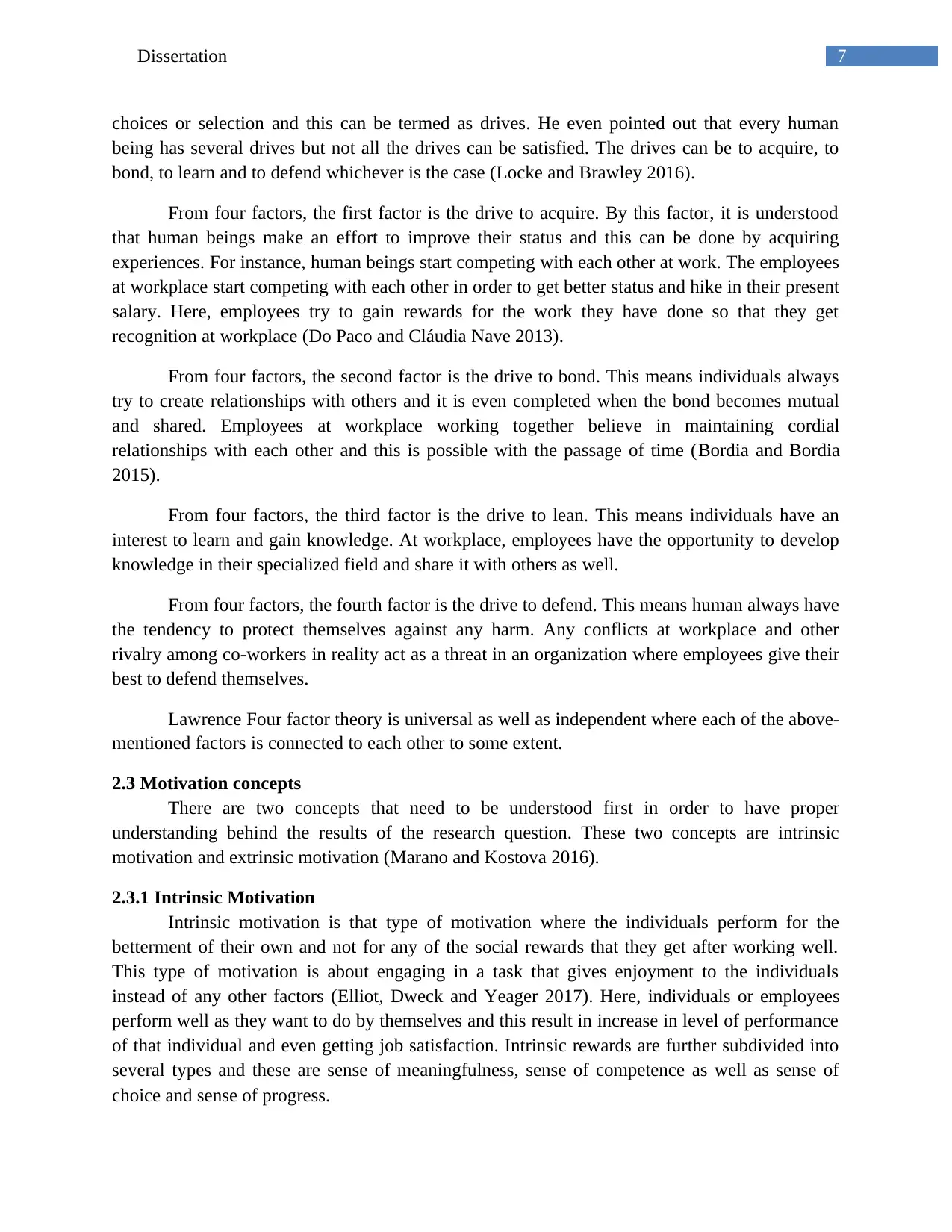
7Dissertation
choices or selection and this can be termed as drives. He even pointed out that every human
being has several drives but not all the drives can be satisfied. The drives can be to acquire, to
bond, to learn and to defend whichever is the case (Locke and Brawley 2016).
From four factors, the first factor is the drive to acquire. By this factor, it is understood
that human beings make an effort to improve their status and this can be done by acquiring
experiences. For instance, human beings start competing with each other at work. The employees
at workplace start competing with each other in order to get better status and hike in their present
salary. Here, employees try to gain rewards for the work they have done so that they get
recognition at workplace (Do Paco and Cláudia Nave 2013).
From four factors, the second factor is the drive to bond. This means individuals always
try to create relationships with others and it is even completed when the bond becomes mutual
and shared. Employees at workplace working together believe in maintaining cordial
relationships with each other and this is possible with the passage of time (Bordia and Bordia
2015).
From four factors, the third factor is the drive to lean. This means individuals have an
interest to learn and gain knowledge. At workplace, employees have the opportunity to develop
knowledge in their specialized field and share it with others as well.
From four factors, the fourth factor is the drive to defend. This means human always have
the tendency to protect themselves against any harm. Any conflicts at workplace and other
rivalry among co-workers in reality act as a threat in an organization where employees give their
best to defend themselves.
Lawrence Four factor theory is universal as well as independent where each of the above-
mentioned factors is connected to each other to some extent.
2.3 Motivation concepts
There are two concepts that need to be understood first in order to have proper
understanding behind the results of the research question. These two concepts are intrinsic
motivation and extrinsic motivation (Marano and Kostova 2016).
2.3.1 Intrinsic Motivation
Intrinsic motivation is that type of motivation where the individuals perform for the
betterment of their own and not for any of the social rewards that they get after working well.
This type of motivation is about engaging in a task that gives enjoyment to the individuals
instead of any other factors (Elliot, Dweck and Yeager 2017). Here, individuals or employees
perform well as they want to do by themselves and this result in increase in level of performance
of that individual and even getting job satisfaction. Intrinsic rewards are further subdivided into
several types and these are sense of meaningfulness, sense of competence as well as sense of
choice and sense of progress.
choices or selection and this can be termed as drives. He even pointed out that every human
being has several drives but not all the drives can be satisfied. The drives can be to acquire, to
bond, to learn and to defend whichever is the case (Locke and Brawley 2016).
From four factors, the first factor is the drive to acquire. By this factor, it is understood
that human beings make an effort to improve their status and this can be done by acquiring
experiences. For instance, human beings start competing with each other at work. The employees
at workplace start competing with each other in order to get better status and hike in their present
salary. Here, employees try to gain rewards for the work they have done so that they get
recognition at workplace (Do Paco and Cláudia Nave 2013).
From four factors, the second factor is the drive to bond. This means individuals always
try to create relationships with others and it is even completed when the bond becomes mutual
and shared. Employees at workplace working together believe in maintaining cordial
relationships with each other and this is possible with the passage of time (Bordia and Bordia
2015).
From four factors, the third factor is the drive to lean. This means individuals have an
interest to learn and gain knowledge. At workplace, employees have the opportunity to develop
knowledge in their specialized field and share it with others as well.
From four factors, the fourth factor is the drive to defend. This means human always have
the tendency to protect themselves against any harm. Any conflicts at workplace and other
rivalry among co-workers in reality act as a threat in an organization where employees give their
best to defend themselves.
Lawrence Four factor theory is universal as well as independent where each of the above-
mentioned factors is connected to each other to some extent.
2.3 Motivation concepts
There are two concepts that need to be understood first in order to have proper
understanding behind the results of the research question. These two concepts are intrinsic
motivation and extrinsic motivation (Marano and Kostova 2016).
2.3.1 Intrinsic Motivation
Intrinsic motivation is that type of motivation where the individuals perform for the
betterment of their own and not for any of the social rewards that they get after working well.
This type of motivation is about engaging in a task that gives enjoyment to the individuals
instead of any other factors (Elliot, Dweck and Yeager 2017). Here, individuals or employees
perform well as they want to do by themselves and this result in increase in level of performance
of that individual and even getting job satisfaction. Intrinsic rewards are further subdivided into
several types and these are sense of meaningfulness, sense of competence as well as sense of
choice and sense of progress.
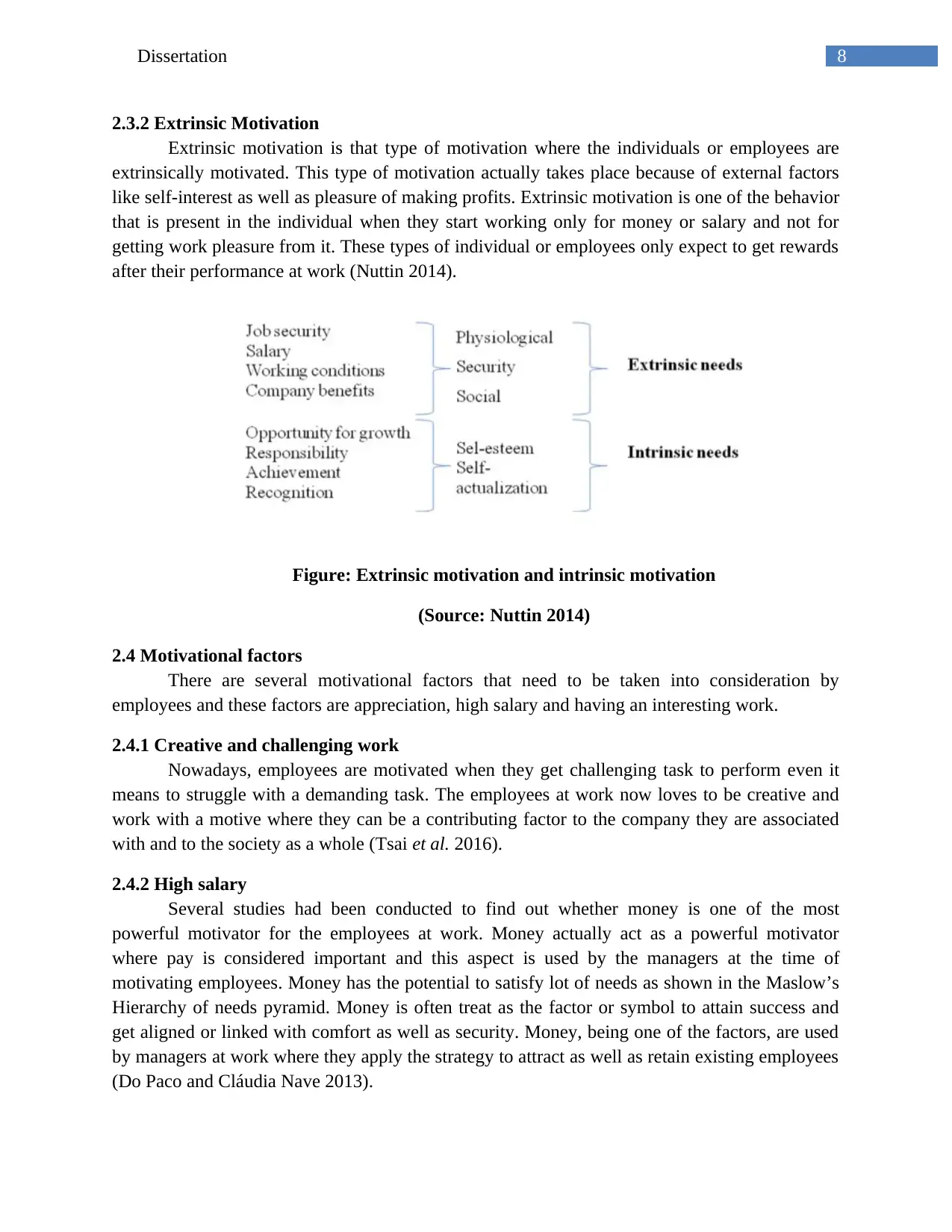
8Dissertation
2.3.2 Extrinsic Motivation
Extrinsic motivation is that type of motivation where the individuals or employees are
extrinsically motivated. This type of motivation actually takes place because of external factors
like self-interest as well as pleasure of making profits. Extrinsic motivation is one of the behavior
that is present in the individual when they start working only for money or salary and not for
getting work pleasure from it. These types of individual or employees only expect to get rewards
after their performance at work (Nuttin 2014).
Figure: Extrinsic motivation and intrinsic motivation
(Source: Nuttin 2014)
2.4 Motivational factors
There are several motivational factors that need to be taken into consideration by
employees and these factors are appreciation, high salary and having an interesting work.
2.4.1 Creative and challenging work
Nowadays, employees are motivated when they get challenging task to perform even it
means to struggle with a demanding task. The employees at work now loves to be creative and
work with a motive where they can be a contributing factor to the company they are associated
with and to the society as a whole (Tsai et al. 2016).
2.4.2 High salary
Several studies had been conducted to find out whether money is one of the most
powerful motivator for the employees at work. Money actually act as a powerful motivator
where pay is considered important and this aspect is used by the managers at the time of
motivating employees. Money has the potential to satisfy lot of needs as shown in the Maslow’s
Hierarchy of needs pyramid. Money is often treat as the factor or symbol to attain success and
get aligned or linked with comfort as well as security. Money, being one of the factors, are used
by managers at work where they apply the strategy to attract as well as retain existing employees
(Do Paco and Cláudia Nave 2013).
2.3.2 Extrinsic Motivation
Extrinsic motivation is that type of motivation where the individuals or employees are
extrinsically motivated. This type of motivation actually takes place because of external factors
like self-interest as well as pleasure of making profits. Extrinsic motivation is one of the behavior
that is present in the individual when they start working only for money or salary and not for
getting work pleasure from it. These types of individual or employees only expect to get rewards
after their performance at work (Nuttin 2014).
Figure: Extrinsic motivation and intrinsic motivation
(Source: Nuttin 2014)
2.4 Motivational factors
There are several motivational factors that need to be taken into consideration by
employees and these factors are appreciation, high salary and having an interesting work.
2.4.1 Creative and challenging work
Nowadays, employees are motivated when they get challenging task to perform even it
means to struggle with a demanding task. The employees at work now loves to be creative and
work with a motive where they can be a contributing factor to the company they are associated
with and to the society as a whole (Tsai et al. 2016).
2.4.2 High salary
Several studies had been conducted to find out whether money is one of the most
powerful motivator for the employees at work. Money actually act as a powerful motivator
where pay is considered important and this aspect is used by the managers at the time of
motivating employees. Money has the potential to satisfy lot of needs as shown in the Maslow’s
Hierarchy of needs pyramid. Money is often treat as the factor or symbol to attain success and
get aligned or linked with comfort as well as security. Money, being one of the factors, are used
by managers at work where they apply the strategy to attract as well as retain existing employees
(Do Paco and Cláudia Nave 2013).
⊘ This is a preview!⊘
Do you want full access?
Subscribe today to unlock all pages.

Trusted by 1+ million students worldwide
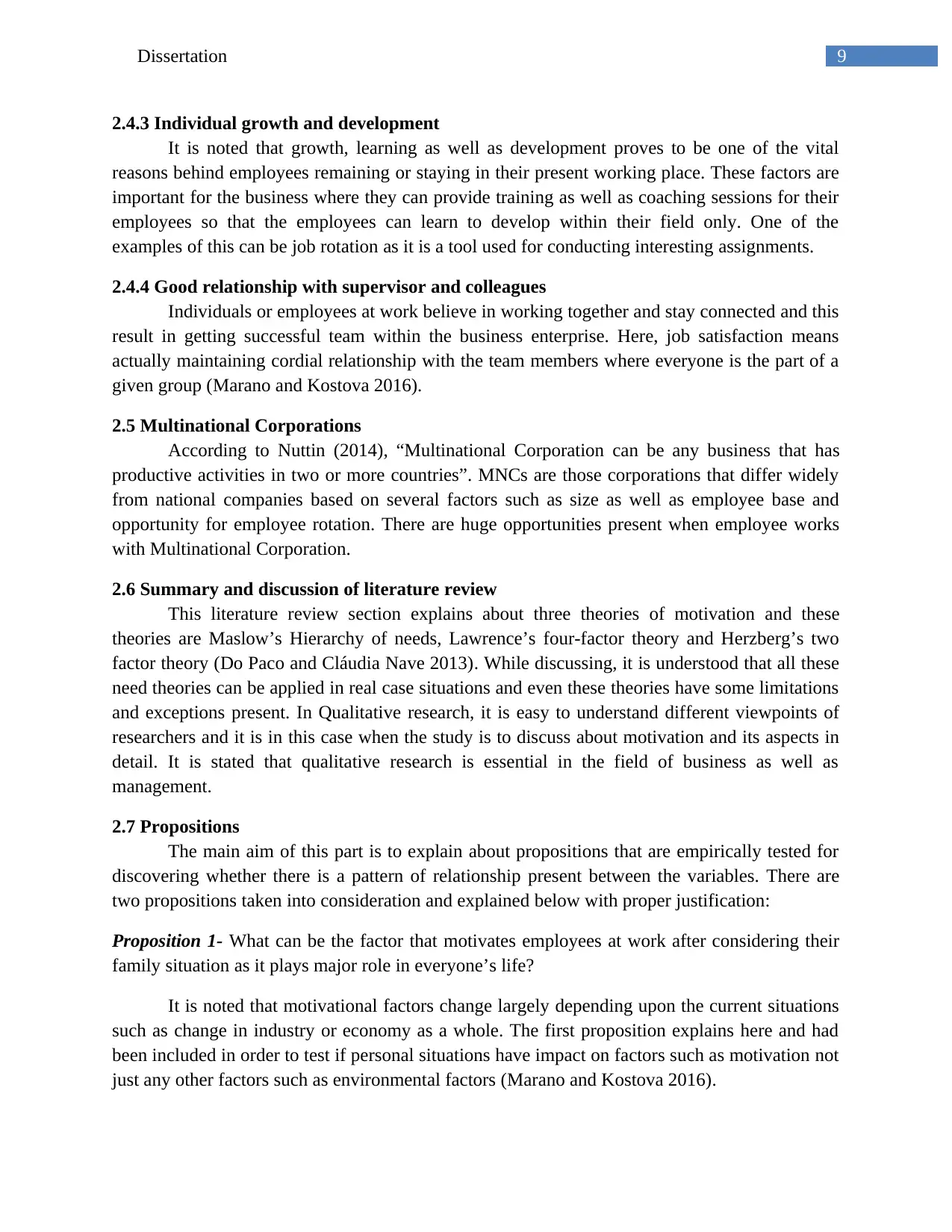
9Dissertation
2.4.3 Individual growth and development
It is noted that growth, learning as well as development proves to be one of the vital
reasons behind employees remaining or staying in their present working place. These factors are
important for the business where they can provide training as well as coaching sessions for their
employees so that the employees can learn to develop within their field only. One of the
examples of this can be job rotation as it is a tool used for conducting interesting assignments.
2.4.4 Good relationship with supervisor and colleagues
Individuals or employees at work believe in working together and stay connected and this
result in getting successful team within the business enterprise. Here, job satisfaction means
actually maintaining cordial relationship with the team members where everyone is the part of a
given group (Marano and Kostova 2016).
2.5 Multinational Corporations
According to Nuttin (2014), “Multinational Corporation can be any business that has
productive activities in two or more countries”. MNCs are those corporations that differ widely
from national companies based on several factors such as size as well as employee base and
opportunity for employee rotation. There are huge opportunities present when employee works
with Multinational Corporation.
2.6 Summary and discussion of literature review
This literature review section explains about three theories of motivation and these
theories are Maslow’s Hierarchy of needs, Lawrence’s four-factor theory and Herzberg’s two
factor theory (Do Paco and Cláudia Nave 2013). While discussing, it is understood that all these
need theories can be applied in real case situations and even these theories have some limitations
and exceptions present. In Qualitative research, it is easy to understand different viewpoints of
researchers and it is in this case when the study is to discuss about motivation and its aspects in
detail. It is stated that qualitative research is essential in the field of business as well as
management.
2.7 Propositions
The main aim of this part is to explain about propositions that are empirically tested for
discovering whether there is a pattern of relationship present between the variables. There are
two propositions taken into consideration and explained below with proper justification:
Proposition 1- What can be the factor that motivates employees at work after considering their
family situation as it plays major role in everyone’s life?
It is noted that motivational factors change largely depending upon the current situations
such as change in industry or economy as a whole. The first proposition explains here and had
been included in order to test if personal situations have impact on factors such as motivation not
just any other factors such as environmental factors (Marano and Kostova 2016).
2.4.3 Individual growth and development
It is noted that growth, learning as well as development proves to be one of the vital
reasons behind employees remaining or staying in their present working place. These factors are
important for the business where they can provide training as well as coaching sessions for their
employees so that the employees can learn to develop within their field only. One of the
examples of this can be job rotation as it is a tool used for conducting interesting assignments.
2.4.4 Good relationship with supervisor and colleagues
Individuals or employees at work believe in working together and stay connected and this
result in getting successful team within the business enterprise. Here, job satisfaction means
actually maintaining cordial relationship with the team members where everyone is the part of a
given group (Marano and Kostova 2016).
2.5 Multinational Corporations
According to Nuttin (2014), “Multinational Corporation can be any business that has
productive activities in two or more countries”. MNCs are those corporations that differ widely
from national companies based on several factors such as size as well as employee base and
opportunity for employee rotation. There are huge opportunities present when employee works
with Multinational Corporation.
2.6 Summary and discussion of literature review
This literature review section explains about three theories of motivation and these
theories are Maslow’s Hierarchy of needs, Lawrence’s four-factor theory and Herzberg’s two
factor theory (Do Paco and Cláudia Nave 2013). While discussing, it is understood that all these
need theories can be applied in real case situations and even these theories have some limitations
and exceptions present. In Qualitative research, it is easy to understand different viewpoints of
researchers and it is in this case when the study is to discuss about motivation and its aspects in
detail. It is stated that qualitative research is essential in the field of business as well as
management.
2.7 Propositions
The main aim of this part is to explain about propositions that are empirically tested for
discovering whether there is a pattern of relationship present between the variables. There are
two propositions taken into consideration and explained below with proper justification:
Proposition 1- What can be the factor that motivates employees at work after considering their
family situation as it plays major role in everyone’s life?
It is noted that motivational factors change largely depending upon the current situations
such as change in industry or economy as a whole. The first proposition explains here and had
been included in order to test if personal situations have impact on factors such as motivation not
just any other factors such as environmental factors (Marano and Kostova 2016).
Paraphrase This Document
Need a fresh take? Get an instant paraphrase of this document with our AI Paraphraser
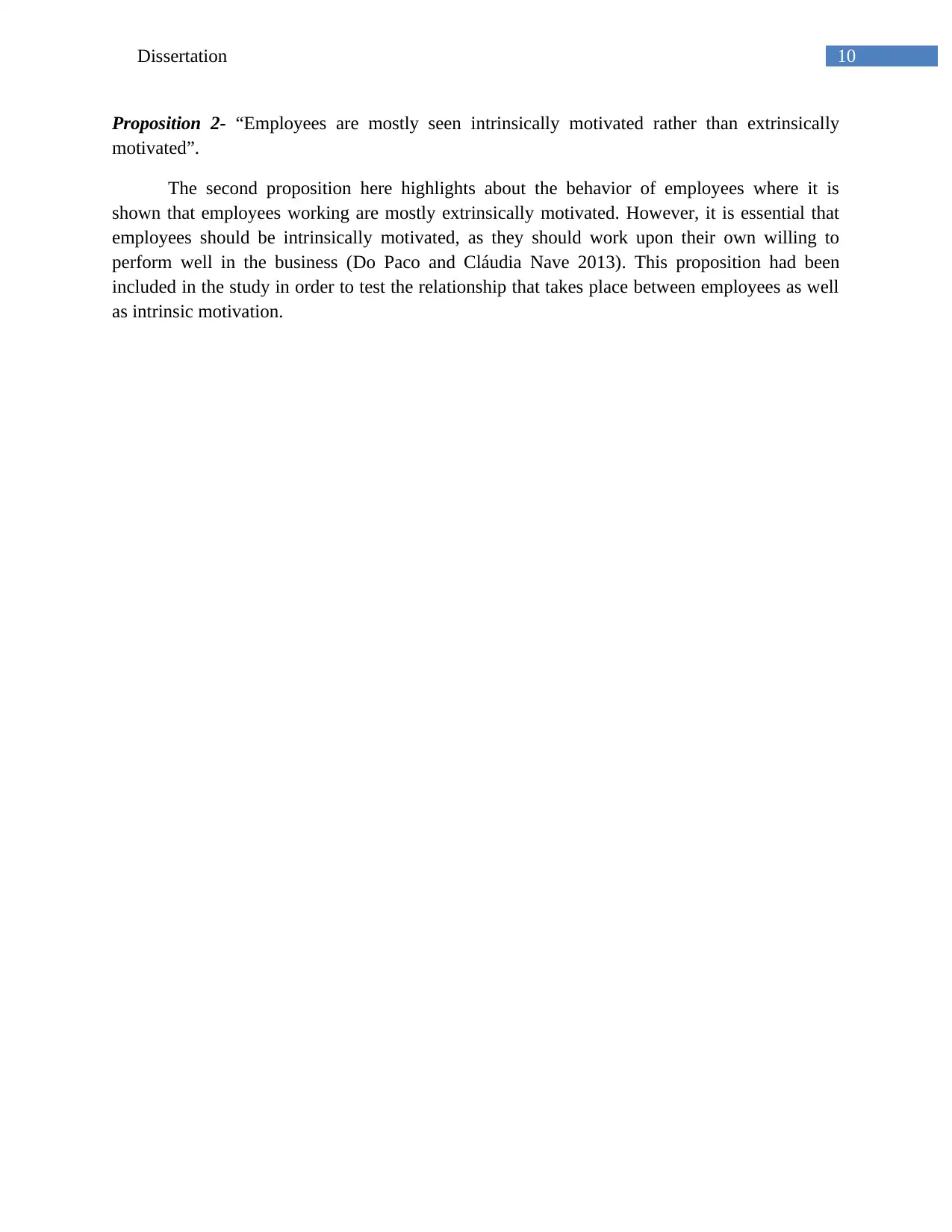
10Dissertation
Proposition 2- “Employees are mostly seen intrinsically motivated rather than extrinsically
motivated”.
The second proposition here highlights about the behavior of employees where it is
shown that employees working are mostly extrinsically motivated. However, it is essential that
employees should be intrinsically motivated, as they should work upon their own willing to
perform well in the business (Do Paco and Cláudia Nave 2013). This proposition had been
included in the study in order to test the relationship that takes place between employees as well
as intrinsic motivation.
Proposition 2- “Employees are mostly seen intrinsically motivated rather than extrinsically
motivated”.
The second proposition here highlights about the behavior of employees where it is
shown that employees working are mostly extrinsically motivated. However, it is essential that
employees should be intrinsically motivated, as they should work upon their own willing to
perform well in the business (Do Paco and Cláudia Nave 2013). This proposition had been
included in the study in order to test the relationship that takes place between employees as well
as intrinsic motivation.
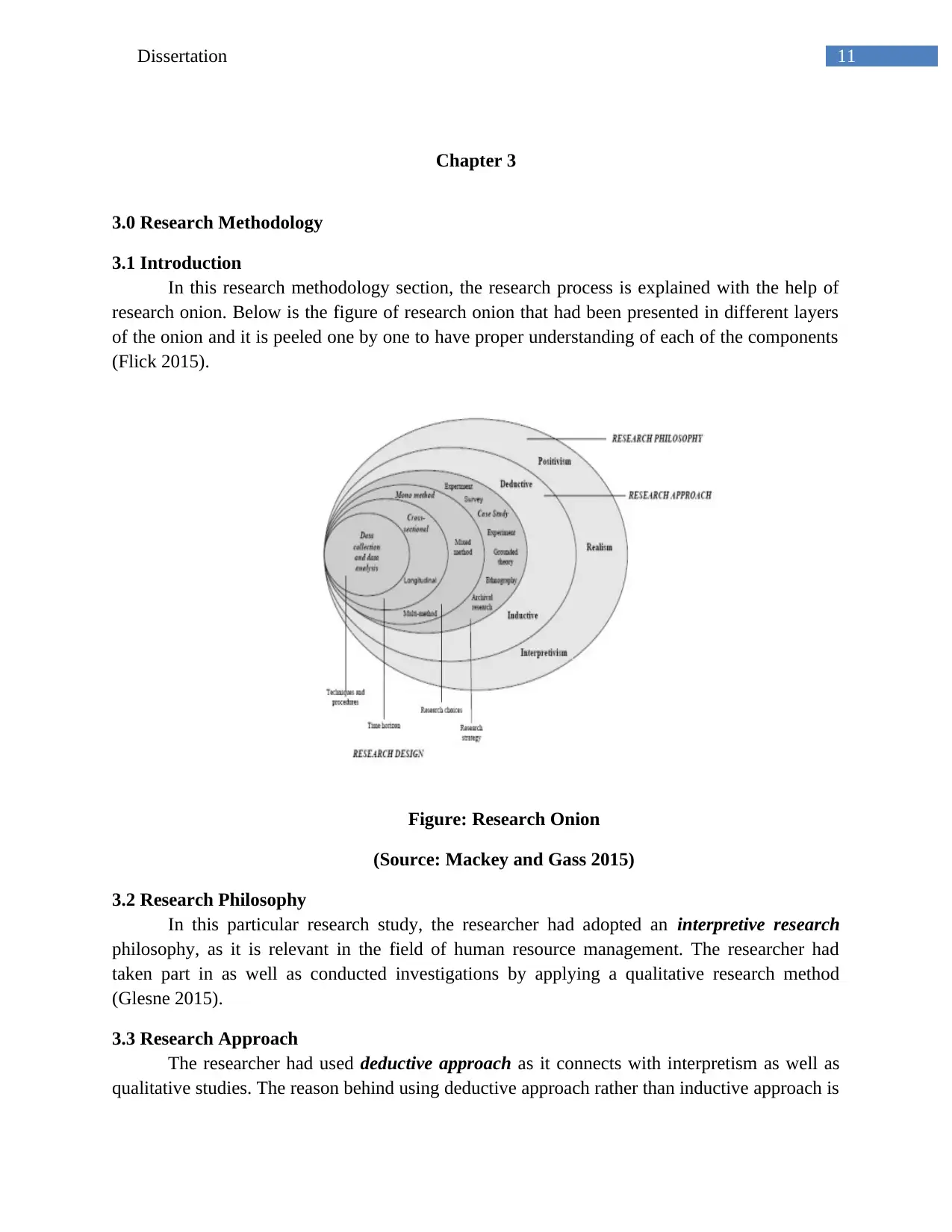
11Dissertation
Chapter 3
3.0 Research Methodology
3.1 Introduction
In this research methodology section, the research process is explained with the help of
research onion. Below is the figure of research onion that had been presented in different layers
of the onion and it is peeled one by one to have proper understanding of each of the components
(Flick 2015).
Figure: Research Onion
(Source: Mackey and Gass 2015)
3.2 Research Philosophy
In this particular research study, the researcher had adopted an interpretive research
philosophy, as it is relevant in the field of human resource management. The researcher had
taken part in as well as conducted investigations by applying a qualitative research method
(Glesne 2015).
3.3 Research Approach
The researcher had used deductive approach as it connects with interpretism as well as
qualitative studies. The reason behind using deductive approach rather than inductive approach is
Chapter 3
3.0 Research Methodology
3.1 Introduction
In this research methodology section, the research process is explained with the help of
research onion. Below is the figure of research onion that had been presented in different layers
of the onion and it is peeled one by one to have proper understanding of each of the components
(Flick 2015).
Figure: Research Onion
(Source: Mackey and Gass 2015)
3.2 Research Philosophy
In this particular research study, the researcher had adopted an interpretive research
philosophy, as it is relevant in the field of human resource management. The researcher had
taken part in as well as conducted investigations by applying a qualitative research method
(Glesne 2015).
3.3 Research Approach
The researcher had used deductive approach as it connects with interpretism as well as
qualitative studies. The reason behind using deductive approach rather than inductive approach is
⊘ This is a preview!⊘
Do you want full access?
Subscribe today to unlock all pages.

Trusted by 1+ million students worldwide
1 out of 20
Related Documents
Your All-in-One AI-Powered Toolkit for Academic Success.
+13062052269
info@desklib.com
Available 24*7 on WhatsApp / Email
![[object Object]](/_next/static/media/star-bottom.7253800d.svg)
Unlock your academic potential
Copyright © 2020–2025 A2Z Services. All Rights Reserved. Developed and managed by ZUCOL.




